Victorian interior design blends timeless elegance with ornate details. This stunning style from the 19th century still captivates homeowners today. It combines rich colors, intricate patterns, and lavish furnishings to create grand spaces.
Victorian style mixes design elements from various historical periods. Each room in a Victorian home tells a unique story. Modern adaptations blend classic elements with contemporary touches for a fresh look.
Victorian home decor stands out from minimalist trends. It focuses on ornate details and lush fabrics for a luxurious feel. This style offers many options for creating a remarkable living space.
You can use jewel tones, vintage lighting, or antique furnishings. Victorian design allows for endless creativity in your home. It’s perfect for those who want to make a bold statement.
Key Takeaways
- Victorian interior design originated in the 19th century
- Rich colors and ornate details characterize the style
- Modern adaptations blend classic and contemporary elements
- Victorian decor offers a luxurious alternative to minimalism
- The style incorporates elements from various historical periods
- Victorian design allows for personalization and creativity
The Origins and Evolution of Victorian Interior Design
Victorian design flourished from 1837 to 1901, named after Queen Victoria. This era saw major changes in design aesthetics. It reflected the social and economic shifts of the time.
The Victorian Era: A Time of Change and Innovation
Rapid industrialization and new technology shaped the Victorian period. These changes brought new materials and manufacturing techniques to interior design. Victorian interiors blended Gothic, Renaissance, and exotic Asian and Middle Eastern styles.
- Gothic Revival architecture became prominent
- Asymmetrical facades replaced balanced designs
- Ornate detailing, including intricate carvings and moldings, gained popularity
- Stained glass windows with vibrant colors became a notable feature
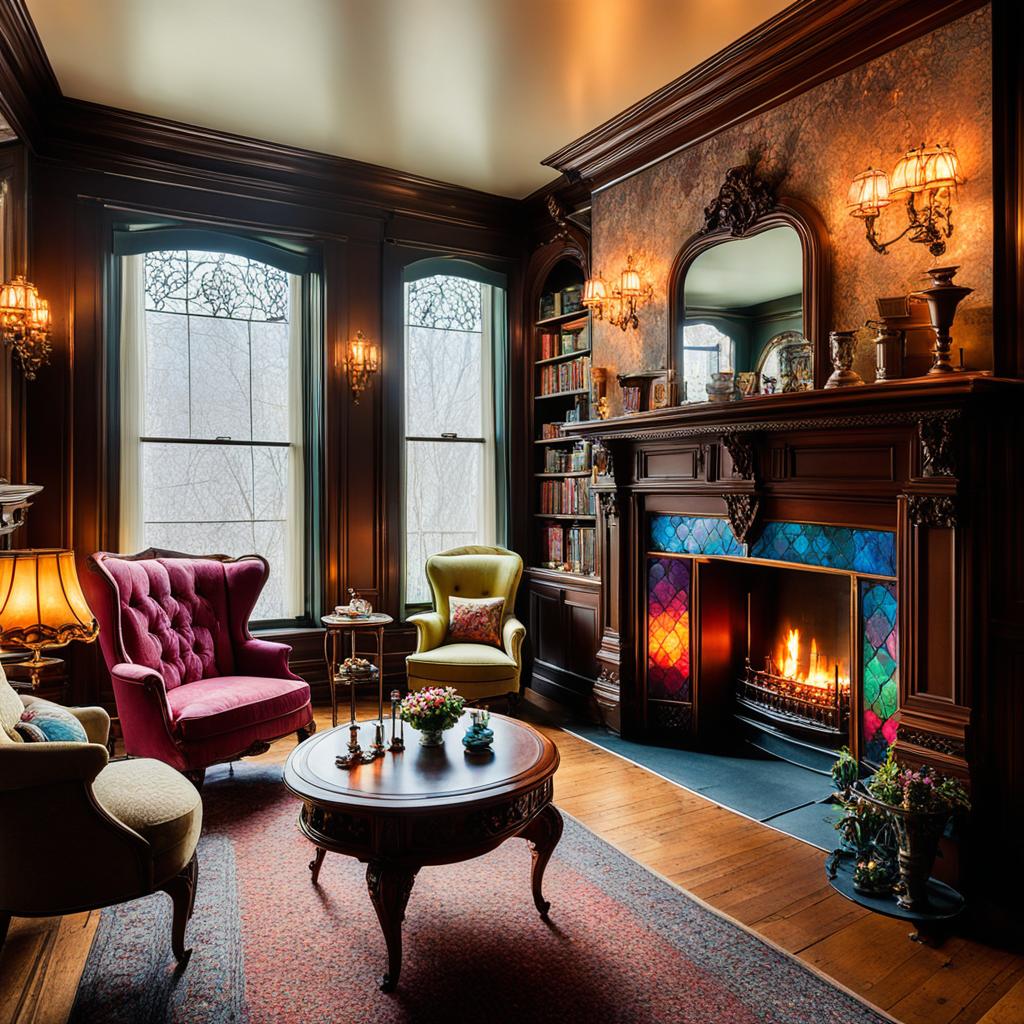
Influence of Queen Victoria on Design Aesthetics
Queen Victoria’s reign greatly influenced design aesthetics. Her impact led to grand and sophisticated historical interiors. Victorian homes often had rooms for specific purposes.
“Victorian interior design emphasized social refinement, decorum, and etiquette.”
From Opulence to Functionality: The Transformation of Victorian Style
Victorian interior design evolved from extreme opulence to more functional designs. This change was driven by society’s needs and manufacturing advancements. The later Victorian period blended practicality with elegance.
Key features of Victorian interior design included:
- Rich color palettes with emerald green, royal blue, and burgundy tones
- Elaborate wallpaper patterns such as florals and damasks
- Heavy drapery made of luxurious fabrics
- Dark wood furniture with intricate carvings
- Ornate stairwells and doorways
Victorian design blended opulence with functionality, leaving a lasting impact. It continues to inspire designers and homeowners today. This era’s style creates timeless elegance in modern homes.
Key Characteristics of Victorian Interior Design
Victorian interior design shines with rich aesthetics and attention to detail. It blends opulence with romance, born during Queen Victoria’s reign (1837-1901). Let’s explore the key elements of this timeless design approach.
Rich Color Palettes and Ornate Patterns
Victorian color schemes embrace deep, luxurious hues. Rooms come alive with jewel tones like burgundy, emerald, and sapphire. These colors create a warm, inviting atmosphere of elegance.
Ornate patterns are a hallmark of Victorian design. Walls, fabrics, and furnishings often feature intricate designs.
- Intricate floral motifs
- Damask patterns
- Geometric designs
- Oriental-inspired prints
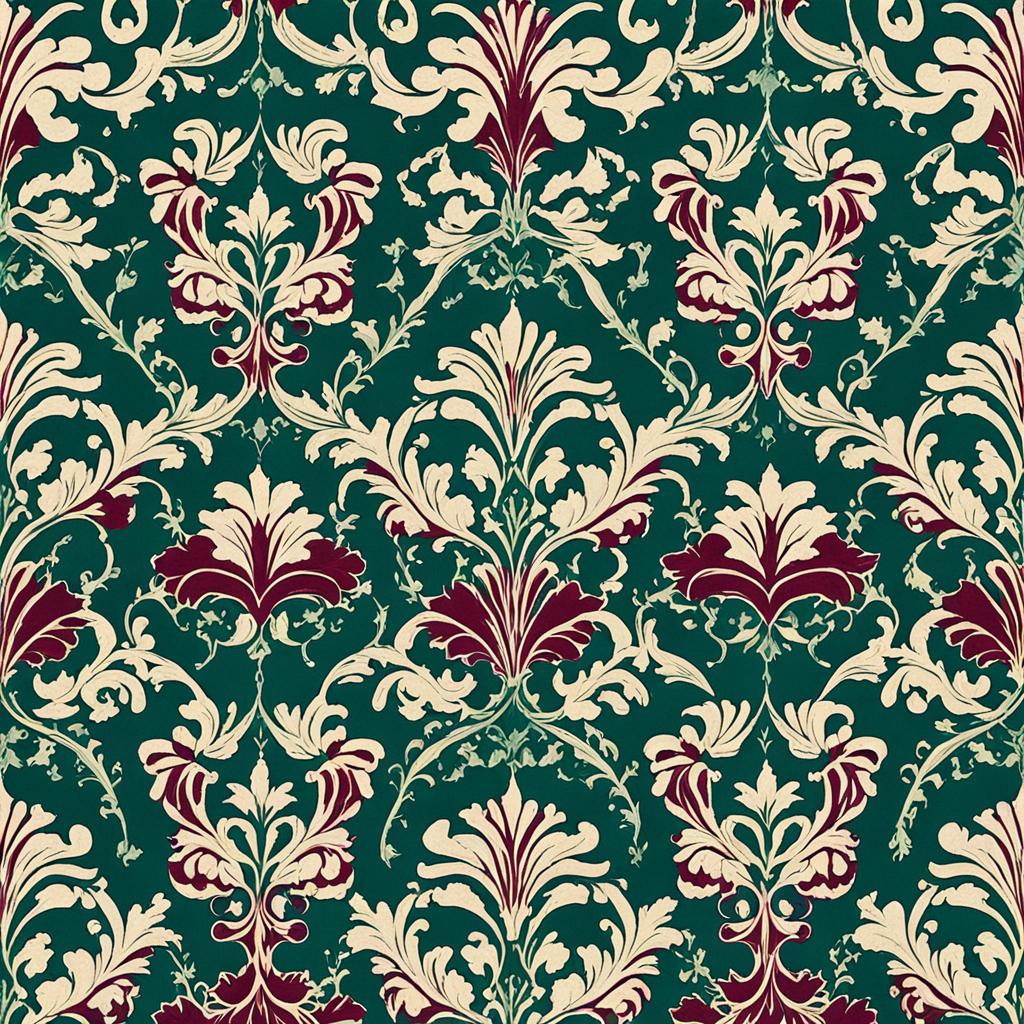
Luxurious Fabrics and Textures
Victorian interiors offer a tactile feast. Luxurious fabrics add depth and comfort to every space. Popular choices include:
| Fabric | Typical Use | Characteristics |
|---|---|---|
| Velvet | Upholstery, Draperies | Soft, plush, light-absorbing |
| Silk | Pillows, Wall Hangings | Smooth, lustrous, lightweight |
| Brocade | Furniture, Curtains | Raised patterns, rich texture |
| Lace | Window Treatments, Tablecloths | Delicate, intricate, airy |
Intricate Architectural Details
Victorian textures extend beyond fabrics to architectural elements. These details add depth and character to rooms:
- Ornate crown moldings
- Decorative wainscoting
- Ceiling medallions
- Carved wooden panels
These architectural details transform plain walls and ceilings into art. They create visual interest and showcase the craftsmanship valued in Victorian times.
“The Victorian home was a canvas for displaying wealth and status, with every element carefully chosen to impress.”
Victorian design blends rich colors, ornate patterns, and luxurious fabrics. It creates spaces that are both grand and inviting. This style still inspires modern designers, proving elegance never fades.
Victorian Furniture Styles and Placement
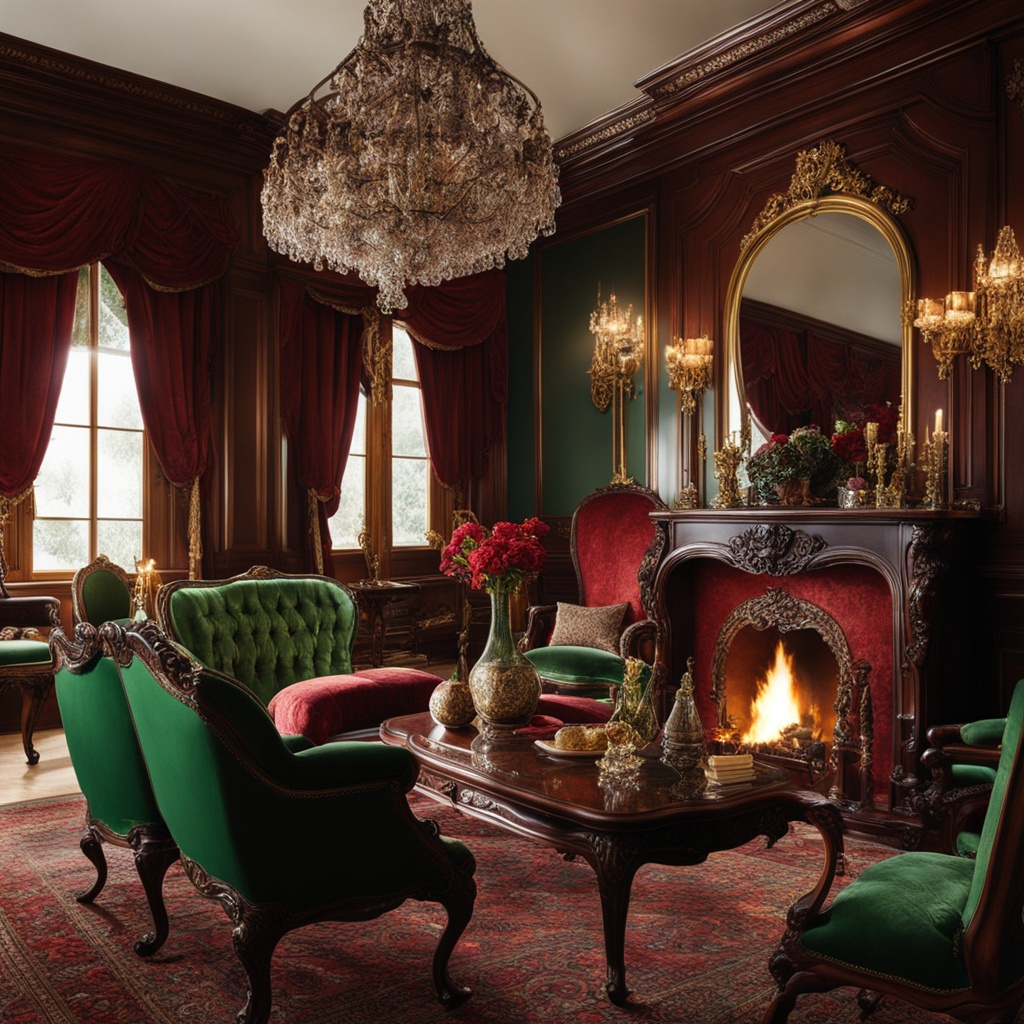
Victorian furniture showcases the grandeur of the 19th century. Crafted from dark woods, these pieces feature intricate carvings and plush upholstery. Machine production made Victorian style furniture more affordable and widely available.
Common Victorian furniture pieces include:
- Chaise lounges
- Fainting couches
- Heavy wooden tables
- Button-back chairs
- Ottomans and pouffes
Victorian upholstery used techniques like tufting and deep buttoning. Fabrics such as velvet and damask in bright colors matched popular floral wallpapers.
Victorian homes had formal, symmetrical furniture placement. The parlor displayed the finest pieces for entertaining guests. Furniture was arranged to encourage conversation and showcase decorative items.
| Wood Types | Upholstery Fabrics | Common Colors |
|---|---|---|
| Oak | Brocade | Ruby Red |
| Walnut | Damask | Forest Green |
| Mahogany | Velvet | Deep Blue |
| Rosewood | Needlepoint | Rich Gold |
Some find Victorian furniture too ornate. Yet, it can turn spaces into luxurious retreats. Carefully chosen Victorian pieces can create timeless elegance in modern homes.
The Art of Victorian Wallpaper and Wall Coverings
Victorian wallpaper defined the era’s interior design. It turned homes into lavish style showcases. The Industrial Revolution made ornate wall coverings more affordable for the middle class.
Popular Patterns and Motifs
Victorian patterns brimmed with detail and symbolism. Floral wallpaper reigned supreme, bringing nature indoors. Other popular motifs included birds, animals, and geometric designs.
Damask patterns and medieval-inspired motifs also adorned walls. William Morris and A.W.N. Pugin shaped Victorian wallpaper design. Their intricate, nature-inspired creations became hallmarks of the era.
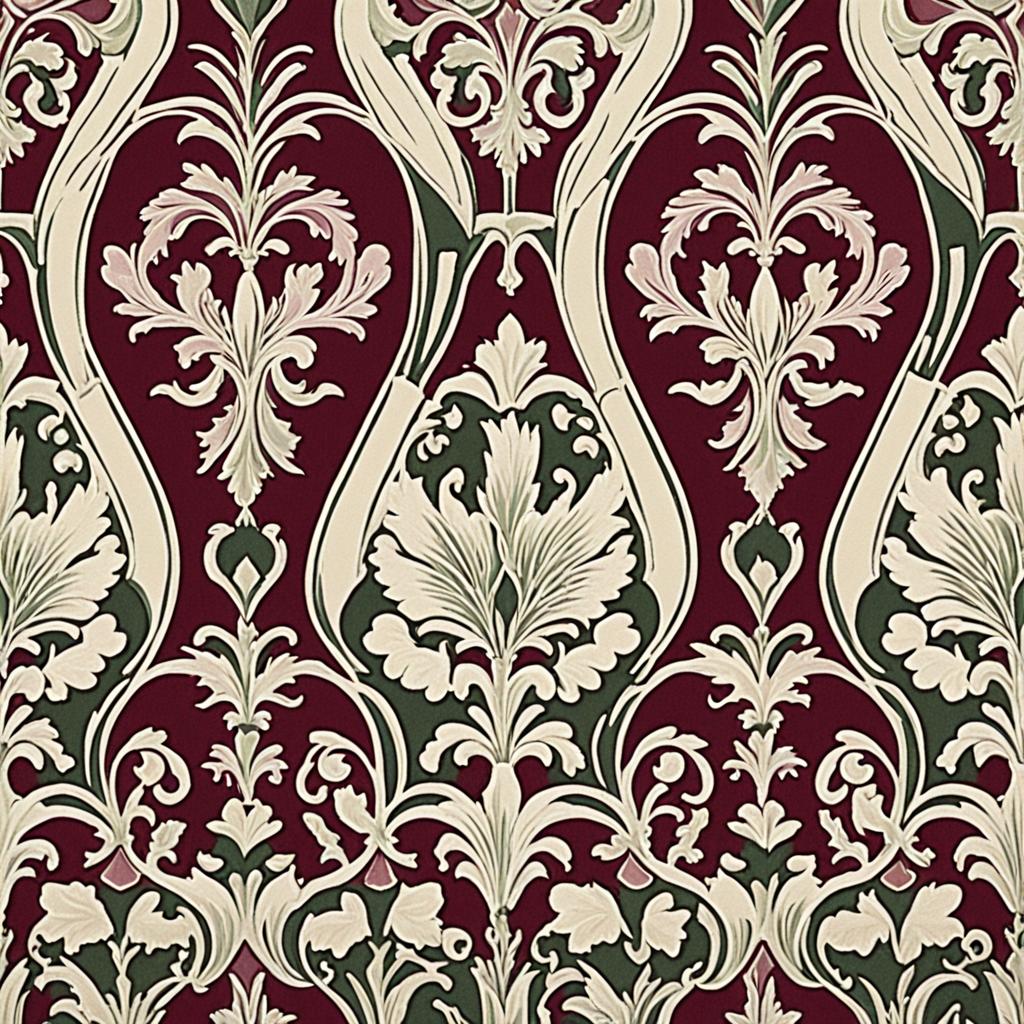
Color Schemes and Their Meanings
Colors in Victorian wall coverings carried symbolic weight. Deep, rich hues were favored. Red signified passion, green represented nature, and blue symbolized tranquility.
Brown conveyed stability and earthiness. These bold colors created opulence in Victorian homes. Flock wallpaper, mimicking cut velvet, added to the luxurious feel.
Modern Adaptations of Victorian Wallpaper
Today’s Victorian wallpaper designs offer fresh takes on classic patterns. Updated versions feature simplified patterns and contemporary color palettes. Many use eco-friendly materials, blending past elegance with modern sensibilities.
These designs let homeowners embrace Victorian charm while staying current. They prove that Victorian-inspired wall coverings can suit modern tastes without losing appeal.
Victorian Lighting: From Candles to Chandeliers
Victorian lighting changed dramatically during Queen Victoria’s 63-year reign. Homes moved from using simple candles to grand chandeliers. This era saw many new lighting inventions.

Early Victorian homes used candles and oil lamps for daily light. Chandeliers were only for special events. Later, gas lighting became common in cities. Electricity slowly entered homes near the end of this time.
Victorian lighting adapted to new needs and styles. Candles stayed popular throughout this period. Tallow, spermaceti, and beeswax were common candle materials. Paraffin wax candles became popular later for being cheap and odorless.
The Rise of Gas Lighting
Gas lighting grew popular after its use in Parliament in 1859. Fancy townhouses in the 1860s had central gas lights and wall brackets. These vintage fixtures often had fancy designs on shades and arms.
- Batswing and Fish Tail burners were typical in gas lighting
- The Argand burner stood out with its circular flame design
- Gas lights were usually positioned over fireplaces or kitchen tables
The Dawn of Electric Lighting
Thomas Edison improved the commercial light bulb in 1879. This started the electric lighting era. Late Victorian gas fixtures were changed to use electric lines and sockets in the 1890s.
The average gas light or early light bulb in the Victorian era was equivalent to a 10-watt bulb, providing a soft, warm glow to Victorian interiors.
Victorian lamps, gas or electric, made pretty pools of light. They often had stained-glass shades. This soft lighting tried to copy the look of 17th-century Dutch paintings.
| Lighting Type | Brightness | Cost | Popularity |
|---|---|---|---|
| Candles | Low | Affordable | Common throughout era |
| Oil Lamps | Medium | Moderate | Popular mid-century |
| Gas Lighting | High | Expensive | Common in urban homes by 1900 |
| Electric Lighting | Highest | Very Expensive | Gaining popularity late era |
Victorian lighting still fascinates people today with its timeless beauty. You can choose real antiques or new copies. These chandeliers and lamps add vintage charm to any home.
Victorian Interior Design: Timeless Elegance at Home
Victorian interior design brings timeless elegance to modern homes. This 19th-century style captivates with rich aesthetics and attention to detail. Let’s explore how to add Victorian charm to your living spaces.
Creating a Victorian-Inspired Living Room
Victorian living rooms exude opulence and comfort. Achieve this look with plush, tufted seating and an ornate fireplace.
- Choose plush seating with tufted upholstery
- Install an ornate fireplace as a focal point
- Hang heavy draperies in rich fabrics
- Add intricate woodwork and moldings
- Incorporate vintage accessories like gilt mirrors and oil paintings

Dark woods like mahogany or walnut add warmth and sophistication. Use rich colors such as deep reds, greens, and golds for a cozy atmosphere.
Victorian Bedroom Design: A Sanctuary of Luxury
Turn your bedroom into a Victorian sanctuary of luxury. Invest in a canopy bed with luxurious linens and ornate wallpaper.
- Invest in a canopy bed with luxurious linens
- Use ornate wallpaper or textured wall coverings
- Add a chaise lounge or fainting couch
- Incorporate antique dressers and vanities
- Display Victorian-inspired artwork and portraits
Victorian bedrooms focus on comfort and romance. Soft colors like lavender, pale blue, or cream create a serene ambiance. Add delicate lace curtains for a touch of elegance.
Victorian-Style Dining Rooms: Formal Elegance for Modern Living
Impress guests with a Victorian dining room. Choose a grand table with ornate details and high-backed, upholstered chairs.
- Choose a grand dining table with ornate detailing
- Use high-backed, upholstered dining chairs
- Install a statement chandelier or pendant light
- Display fine china and crystal in a glass-front cabinet
- Add a sideboard for serving and storage
Victorian dining rooms showcase formal elegance. Deep colors like burgundy or forest green create a sophisticated atmosphere. Add elaborate place settings and statement lighting fixtures.
“The Victorian era was a time of opulence and grandeur, reflected in every aspect of home design.”
Create elegant interiors that honor the Victorian era while suiting modern lifestyles. The key to Victorian design is in the details.
From ornate patterns to luxurious textures, every element adds to the timeless elegance. Embrace this style to transform your home into a Victorian-inspired haven.
Incorporating Victorian Elements in Modern Homes
Victorian design offers timeless elegance for contemporary living spaces. We’ll explore ways to blend old-world charm with modern comfort. This unique aesthetic combines classic style and current trends.
Blending Old and New: The Modern Victorian Aesthetic
Modern Victorian style fuses 19th-century grandeur with today’s amenities. It creates spaces that are both nostalgic and functional. San Francisco boasts over 14,000 historic homes showcasing this blend.
Many feature updated interiors that respect their Victorian roots. This approach maintains character while adding modern conveniences.
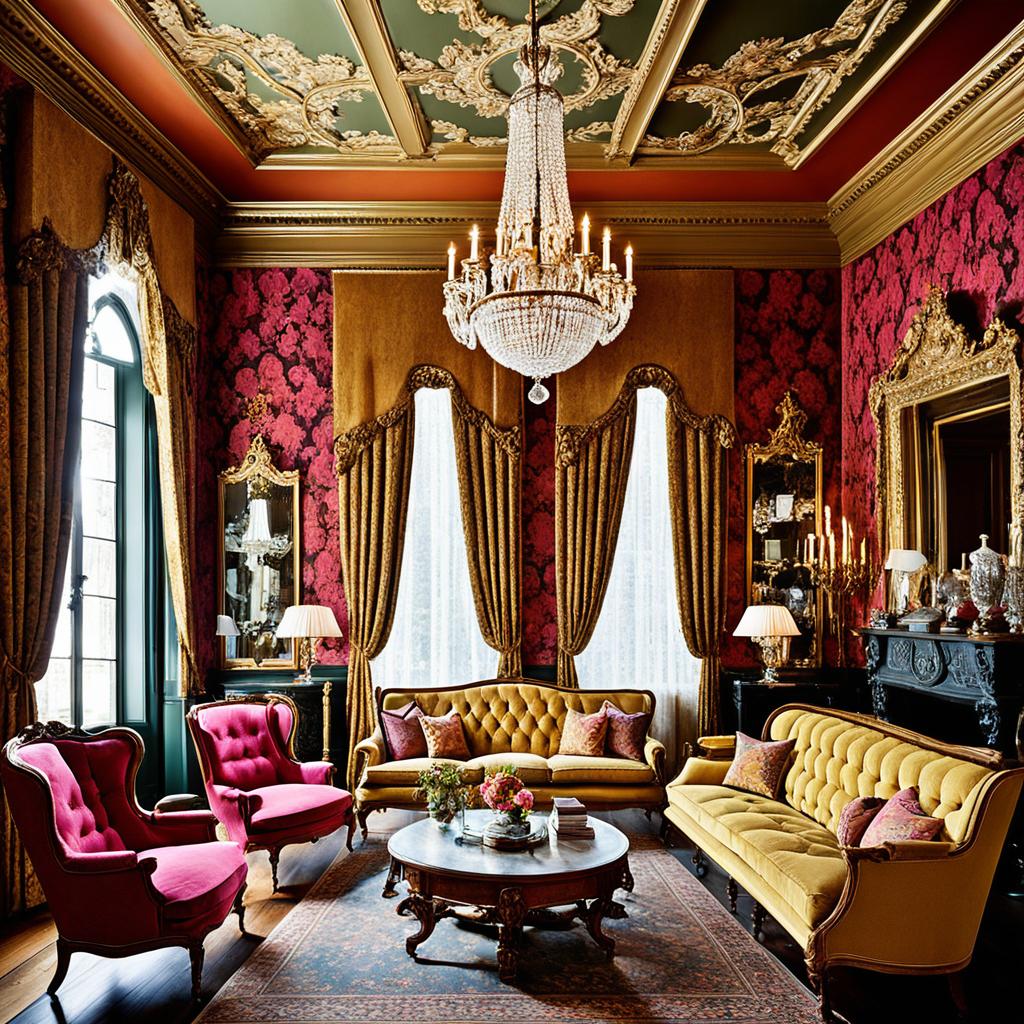
- Use light color palettes to brighten dark Victorian interiors
- Mix antique and modern furniture pieces
- Incorporate technology discreetly
- Contrast periods through lighting fixtures
Victorian-Inspired Accent Pieces and Decor
Victorian-inspired decor adds character to any space. Focus on these key elements:
- Intricate moldings and ornate detailing
- Classic furniture with modern upholstery
- Rich color palettes in small doses
- Luxurious fabrics for pillows and curtains
In modern Victorian design, less is often more. Choose a few statement pieces instead of cluttering every surface.
Adapting Victorian Design for Small Spaces
Victorian design can work in compact homes too. Here’s how to add Victorian accents in small spaces:
- Use decorative molding to enhance wall interest
- Opt for one ornate mirror as a focal point
- Choose furniture with Victorian-inspired details but modern proportions
- Apply Victorian-inspired wallpaper on a single accent wall
Focus on key elements and use them sparingly. This creates a Victorian-inspired space that feels grand and cozy.
| Traditional Victorian | Modern Victorian |
|---|---|
| Dark, rich colors | Neutral palette with pops of color |
| Heavy draperies | Lighter window treatments |
| Ornate patterns everywhere | Selective use of patterns |
| Antique furniture | Mix of antique and modern pieces |
Thoughtfully incorporate these elements into your home. You’ll create a space honoring Victorian elegance while embracing modern living.
Victorian Window Treatments: Draperies and Lace
Victorian curtains were the crown jewel of 19th-century interior design. They turned ordinary rooms into lavish spaces fit for royalty. Heavy draperies and delicate lace curtains created a stunning visual effect.
The 1860s saw mass-produced roller blinds emerge. These offered a practical alternative to traditional curtains. Spring blinds, invented in the 1830s, provided even more options for homeowners.
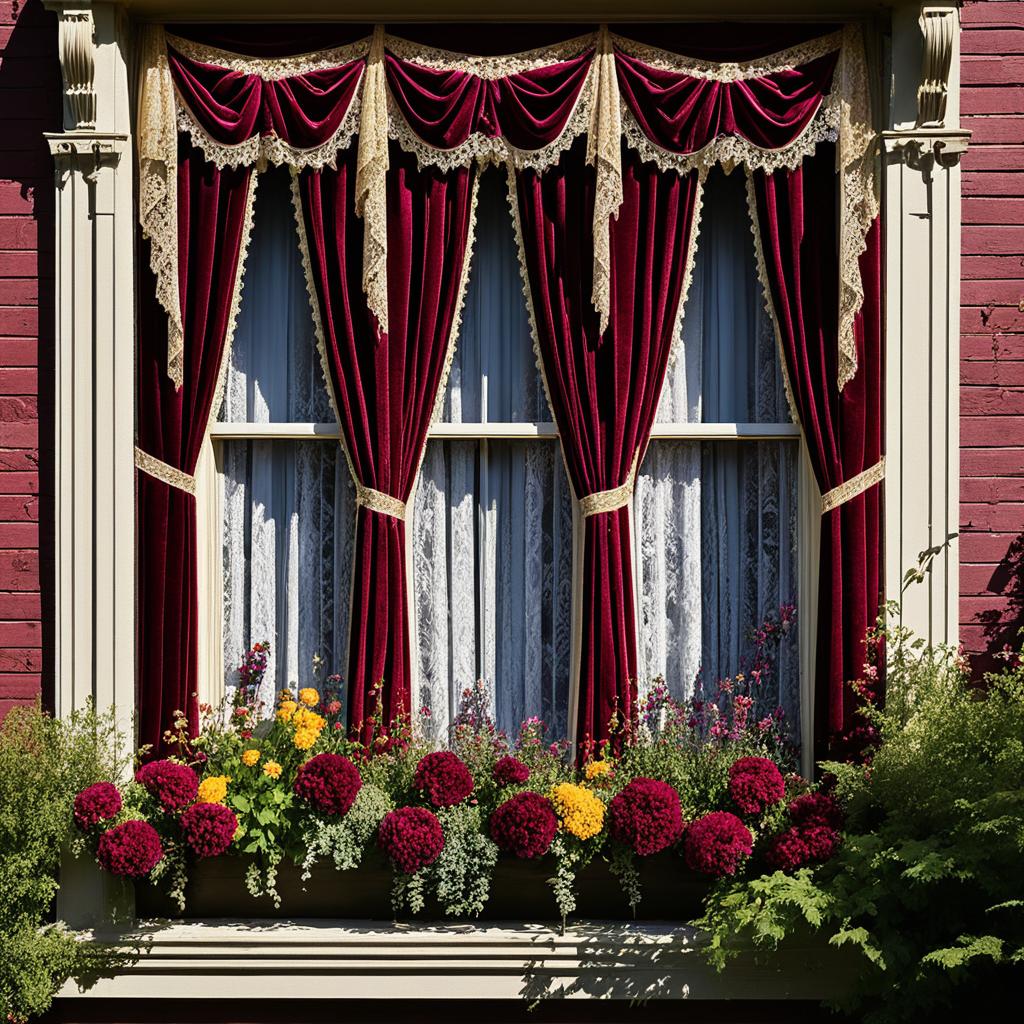
Victorian window treatments focused on luxury and layering. A typical setup included various elements for a grand look.
- Floor-length heavy draperies with ornate patterns
- Sheer lace curtains for privacy and light filtering
- Decorative valances or pelmets at the top
- Tiebacks adorned with tassels or fringe
Lace curtains were a Victorian must-have. They let light in while maintaining privacy. These delicate coverings created a soft, romantic feel in rooms.
Victorian-style curtains can blend with modern elements. Grommet top drapes offer a fresh twist on classic designs. This mix of old and new creates an appealing look.
“Victorian window treatments add elegance to any room. Heavy draperies and delicate lace create a timeless look that never fades.”
You can embrace Victorian-inspired window treatments without overspending. Many stores offer bulk savings on curtain panels. You might save 5% on multiple panels or get $14.16 per panel for four or more.
Victorian-style window treatments still charm homeowners today. They can turn your living space into a Victorian-inspired haven. Choose from authentic antiques or modern versions to suit your taste.
The Role of Antiques in Victorian Interior Design
Victorian antiques are key to creating authentic period-inspired interiors. These pieces add history and elegance to modern homes. They showcase the rich design heritage of the Victorian era (1837-1901).
Sourcing Authentic Victorian Pieces
Finding genuine Victorian antiques takes patience and knowledge. Reputable dealers, auctions, and estate sales are great sources. Look for handcrafted details and rich, dark woods like mahogany or walnut.
Seek out ornate carvings, inlays, and original hardware. These features are hallmarks of authentic Victorian pieces.
- Handcrafted details
- Rich, dark woods like mahogany or walnut
- Ornate carvings and inlays
- Original hardware and finishes
Caring for and Displaying Victorian Antiques
Proper care keeps Victorian antiques beautiful and valuable. Dust often with a soft, dry cloth. Avoid direct sunlight to prevent fading.
Use furniture wax sparingly to protect wood surfaces. Display pieces away from heat sources and busy areas.
- Dust regularly with a soft, dry cloth
- Avoid direct sunlight to prevent fading
- Use furniture wax sparingly to protect wood surfaces
- Display pieces away from heat sources and high-traffic areas
Incorporating Reproductions in Victorian-Inspired Decor
High-quality reproductions can capture the Victorian look if authentic pieces aren’t available. Choose items with accurate period details and quality materials. Ensure proper scale and proportion in your selections.
- Accurate period details
- Quality materials and construction
- Proper scale and proportion
Mix reproduction furniture with vintage decor like mirrors, lamps, and textiles. This creates a cohesive Victorian-inspired look. You can enjoy Victorian elegance without the high cost of authentic antiques.
| Item | Authentic Victorian | Quality Reproduction |
|---|---|---|
| Craftsmanship | Handmade | Machine-made with hand-finishing |
| Materials | Solid wood, original upholstery | Solid wood or veneers, modern fabrics |
| Value | Increases over time | Depreciate slightly |
| Availability | Limited | Readily available |
Choose Victorian antiques or reproductions with care. This helps create a timeless, elegant interior. Your space will honor this rich design era.
Conclusion: Embracing Victorian Elegance in the 21st Century
Victorian revival continues to captivate homeowners and designers. It offers a timeless design aesthetic that blends the past with the present. Modern Victorian-inspired homes showcase this rich style’s enduring appeal, adapted for today’s living.
Victorian-inspired interiors balance opulence and functionality. They incorporate luxurious fabrics like velvet and brocade alongside practical modern furnishings. The key is selecting statement pieces that embody Victorian elegance.
Ornate chandeliers and intricately carved furniture are excellent choices. These should be balanced with a clean, uncluttered overall design. This approach creates a sophisticated yet comfortable space.
Victorian design offers endless possibilities for unique, personalized spaces. Rich color palettes and luxurious textures can be combined with architectural details. This timeless appeal ensures these interiors remain stylish and inviting for years.
